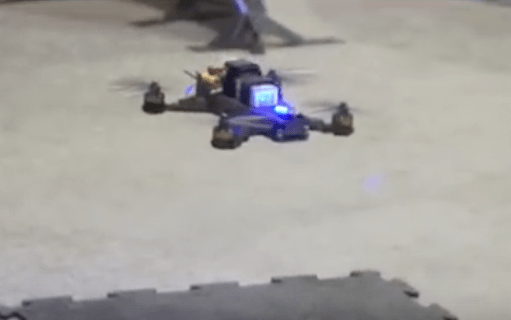
Researchers at NASA’s Jet Propulsion Laboratory in Pasadena, California, recently held a drone race. While the twisting obstacle course was typical for a difficult race -the competitors were anything but typical. Three racing drones controlled by artificial intelligence (A.I.) were pitted against a racing drone flown by expert professional pilot Ken Loo.
Loo won, on speed – but the race showed that AI drones could outperform humans on consistency over time.
“The race, held on Oct. 12, capped off two years of research into drone autonomy funded by Google,” says a NASA press release. “…The team built three custom drones (dubbed Batman, Joker and Nightwing) and developed the complex algorithms the drones needed to fly at high speeds while avoiding obstacles. These algorithms were integrated with Google’s Tango technology, which JPL also worked on.”
Batman, Joker and Nightwing were built to fly as fast as 80 mph (129 kph) in a straight line. “But on the obstacle course set up in a JPL warehouse, they could only fly at 30 or 40 mph (48 to 64 kph) before they needed to apply the brakes,” says the release.
“We pitted our algorithms against a human, who flies a lot more by feel,” said Rob Reid of JPL, the project’s task manager. “You can actually see that the A.I. flies the drone smoothly around the course, whereas human pilots tend to accelerate aggressively, so their path is jerkier.”
“Compared to Loo, the drones flew more cautiously but consistently. Their algorithms are still a work in progress. For example, the drones sometimes moved so fast that motion blur caused them to lose track of their surroundings,” says NASA.
Loo flew faster, and with more style – he was able to handle the course and his drone impressively. But over time, Loo suffered from exhaustion, something that doesn’t affect an AI-powered drone.
“This is definitely the densest track I’ve ever flown,” Loo said. “One of my faults as a pilot is I get tired easily. When I get mentally fatigued, I start to get lost, even if I’ve flown the course 10 times.”
Loo proved that human experts can learn quickly – out thinking the drones to get faster times. “While the A.I. and human pilot started out with similar lap times, after dozens of laps, Loo learned the course and became more creative and nimble. For the official laps, Loo averaged 11.1 seconds, compared to the autonomous drones, which averaged 13.9 seconds,” says the release.
The advantage that the AI drones showed was in consistency – they were able to fly the same line every time.
“Our autonomous drones can fly much faster,” Reid said. “One day you might see them racing professionally!”
Miriam McNabb is the Editor-in-Chief of DRONELIFE and CEO of JobForDrones, a professional drone services marketplace, and a fascinated observer of the emerging drone industry and the regulatory environment for drones. Miriam has penned over 3,000 articles focused on the commercial drone space and is an international speaker and recognized figure in the industry. Miriam has a degree from the University of Chicago and over 20 years of experience in high tech sales and marketing for new technologies.
For drone industry consulting or writing, Email Miriam.
TWITTER:@spaldingbarker
Subscribe to DroneLife here.
